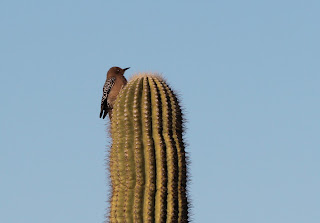Thursday, January 21
34 degrees at 7:30 this morning, with a nice sunrise. We made coffee and then headed a bit north to
Saguaro National Park, with a few stops along the way for photos. The Saguaro are thick here, in “forests”,
along with many other types of cacti.
We arrive at the visitor’s center to find that it isn’t open
yet, so we drive to the Bajada Loop, a several mile long dirt road through the
saguaro desert. We stop here and there
for a ramble, and take some photos while the morning light is still warm.
We catch a few birds atop cacti and later find out that they
are the Gilded Flicker (somewhat rare, we are told) and the Gila Woodpecker
(brown headed female, brown with red spot male). The woodpecker is prolific and responsible
for many of the holes in the cactus, where they nest and lay eggs, then abandon
to other animals like the elf owl.
We go back to visitor’s center to check in – though the fee
is waived with our pass, they still like to have a record of the numbers of
visitors for funding purposes, so we try to sign in everywhere. Chat with the rangers, then retreat to the
Trek for breakfast before heading out.
The winding, undulating road continues till we reach I-10 north, toward
Phoenix.
There are quite a few Orthodox folks among the visitors, and
they and the monks are dressed in black.
A few monks greet folks and
answer questions, and we see few others.
The grounds are gorgeous, with immaculate landscaping,
citrus and olive groves. And several
impressive chapels filled with icons and elaborate lighting. The outside of the buildings have intricate
detail and nicely designed tile roofs, bell towers, arches, etc.
At the exit there are two large bins of oranges and lemons
with a sign saying, “monastery blessings, help yourself”. They offered cookies and other goodies for
sampling as well, and had other items for sale.
We couldn’t pass up the Baklava! Most of the signs are in Greek and English and many of the people were speaking Greek.
Just a few miles away is Casa Grande National Monument,
showcasing ruins from around 1300. The
major ruin is the “Great House” which was 4 stories high. The remnants are under a protective covering
now and there are obvious signs of re-enforcement and support work to keep it
all from tumbling down. It was the first
archeological find to be protected by the government (1896).
We sit under a ramada, shaded area, and listen to a ranger
who tells us about life back then. There
actually was quite a bit of farming and the Gila and Salt Rivers provided irrigation
in an impressive network of canals. Many
of the southwest Indians used this method which, of course, they lost when the
Rivers were dammed and settlers took water for cattle and ranching.
We spend the night at a nearby Walmart in the small town of
Coolidge, along with quite a few others.
The Walmarts in Tucson and Phoenix generally do not allow overnights.















No comments:
Post a Comment